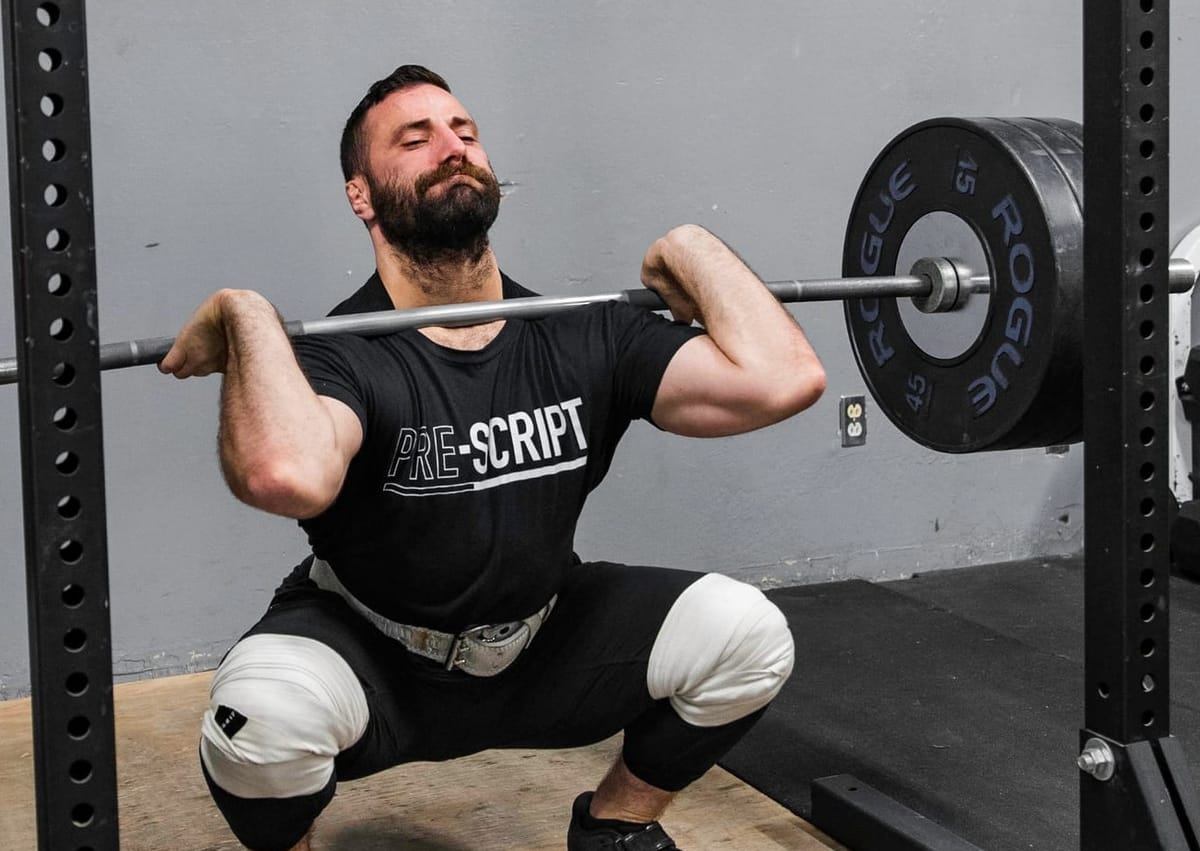
The Goblet Squat and Front Squat are invaluable for developing centre of mass control.
Nearly everyone ever setting foot in a gym has performed a Goblet Squat. As a choice tool for learning the ropes of lower body training, the exercise is popularly classified as a regressive, remedial-level drill. Which is a shame, really; this perspective hides a complex set of adaptations that help very strong people move even heavier loads.
Conversely, the front squat's application in hypertrophy and strength training is much more intuitive; most of us understand its "knee dominant" mechanical nature, and how that translates to greater quad demand. Less intuitive, however, are the same complex adaptations common to the goblet squat.
Where these exercises really shine is the development of centre of mass management: a key quality crucial to the expression of maximal force output.
Good centre of mass management means getting more out of your legs.
At varying points of our respective training journeys, we've all inevitably seen this image. Jordan refers to the figure represented here as "Sagittal Steve". Sagittal Steve diagrams have a lot of problems- but we'll save musing on those for a later date.
The mechanics depicted in this diagram are absolutely valid- that part isn't up for debate. The important thing to note, though, is the key word above- mechanics. These are simple mechanics: nothing more than the effect of gravity applying force leverage to articulating fulcrums.

Diagrams of simple mechanics are helpful for communicating fundamental principles, but they largely fail us when we enter the gym. In reality, the way humans move is far more complicated than the limited scope of mechanics. This is where biomechanics comes in- and with it, the concept of centre of mass management.
So, if mechanics dictate which joints are more or less levered, biomechanics dictate which muscles are used to move the joints, and how they operate.
Centre of mass control influences muscle recruitment and bolsters force transfer.
In conjunction with the mechanics of the exercise itself, the organization of the body's centre of mass largely controls which proximal muscles are recruited to produce force, and the extent to which those muscles are recruited. It also influences through which tissues and structures force is transferred.
${component=BasicCard}Centre of Mass Control
The ability to set the pelvis, ribcage, and spine to advantageous relative orientations that are conducive to the demands of the exercise, and to hold those relative orientations throughout the full range of motion.
As an example of the former, centre of mass organization effectively selects which of the glutes, hamstrings, or adductors are predominantly responsible for extending the hip.
As an example of the latter, centre of mass organization influences the degree to which external axial force is transferred through and managed by the lats, glutes, QLs, SI joints, and spinal erectors.
This is where the conversation shifts from "mechanics" (moment arms and leverage) to biomechanics (the combination of the foregoing with the active interaction/intervention of a live musculoskeletal system).
Applying centre of mass control to squats.
Here's a simplified concept of what "good centre of mass control" means in the context of a squat:
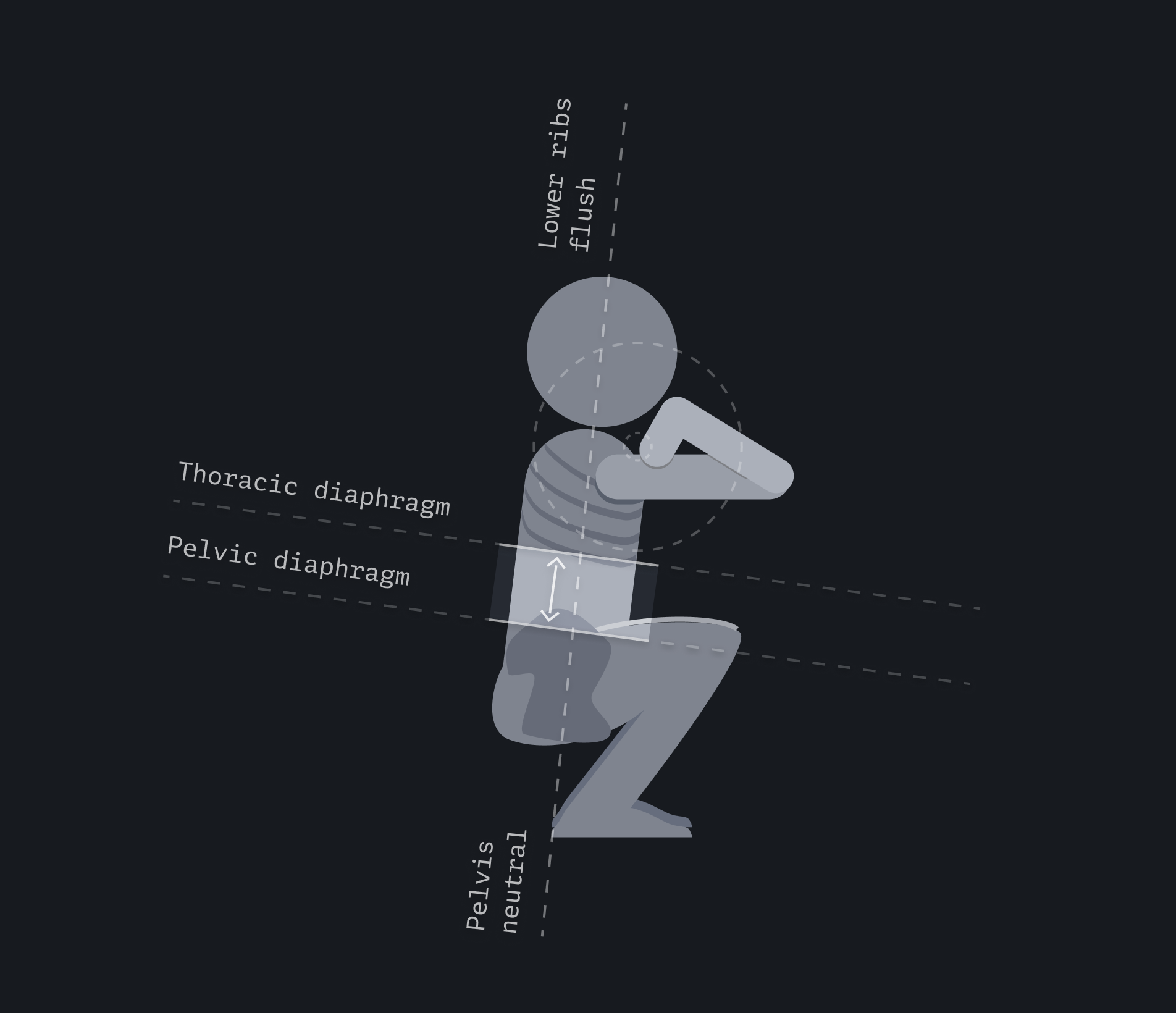
Great - we have our basic "whats" out of the way. So how exactly does good centre of mass management translate into "more gains"?
Good COM control means that target musculature receives as much tension as possible.
In the context of lower body training, the key benefit we get from good COM control is pelvic stability. This sounds boring, but it's an absurdly crucial factor in driving hypertrophy and strength development across lower body musculature. Without it, we run into frustrating plateaus in strength and muscle development.
${component=BasicCard}Stable Pelvis -> Greater Stress on Muscle Tissue
As a general principle, we're able to place much more stress across muscle tissues if the origin and insertion points are held in place. Whenever a muscle's origin/insertion points shift, the muscle shortens/lengthens artificially as a consequence, rather than simply shortening through intentional force-generating contraction.
Let's illustrate this concept with an example.
Back squats are often programmed as a staple lower body strength development exercise, with glutes often designated as the primary muscular target. Bad centre of mass management generally means losing the respective pelvic and ribcage position mid-rep, which heavily diminishes the net tension (and training stimulus) applied to the glutes.

Good centre of mass management means keeping the ribcage and pelvis in their respective "stacked" orientations, which allows the glutes to express output force by way of a more even contraction.
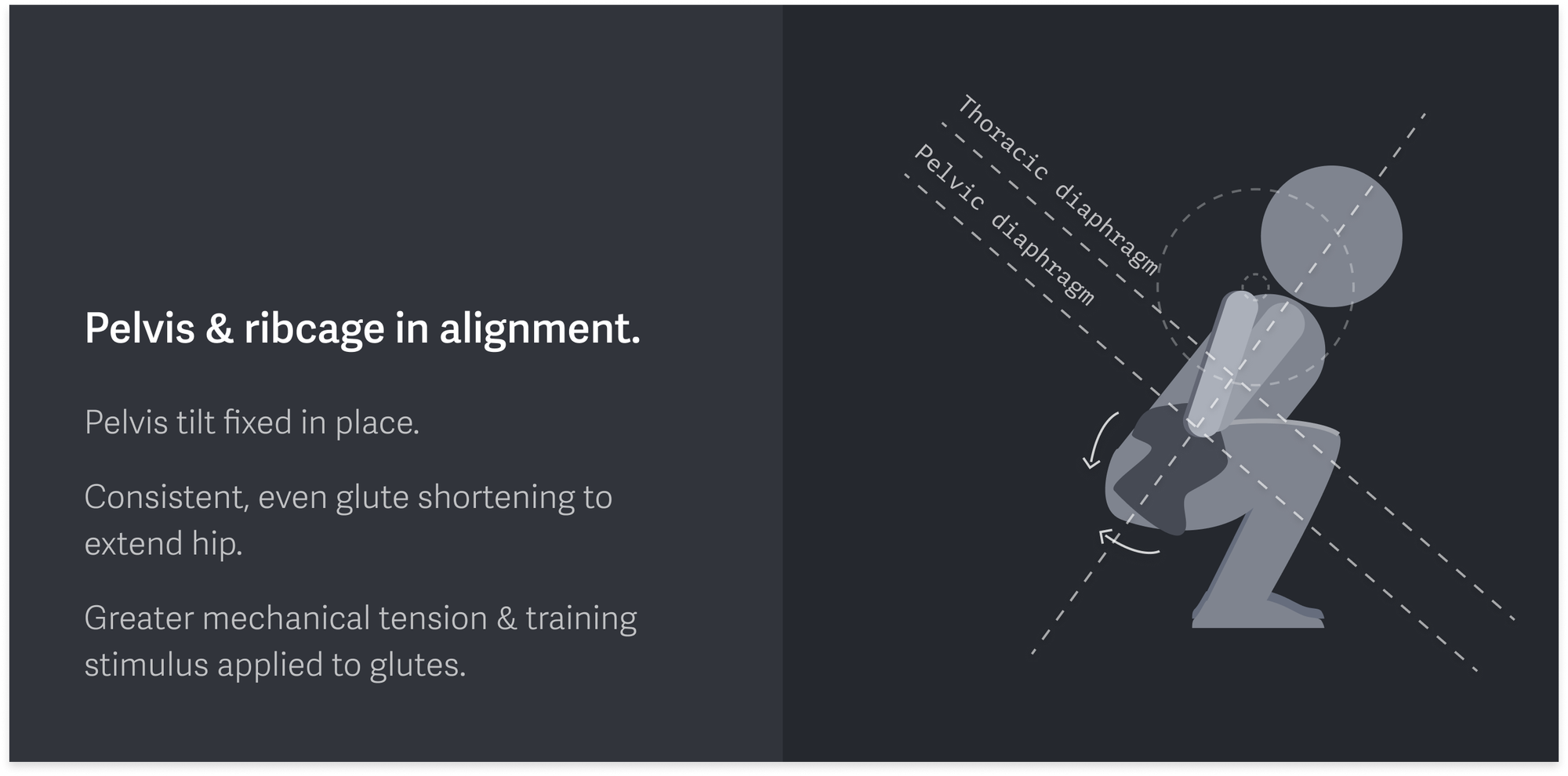
Good COM control means that we can output more overall force.
The well-organized pelvis, ribcage, and spine that result from good COM control has an extremely powerful benefit of its own: This stacked position also happens to be the most mechanically advantageous orientation in which to produce and transfer force.
A full breakdown of this position is outside the scope of this article. The key points to note for our conversation, however, are:
${component=BasicCard}Why the "stacked position" matters
The stacked position generally places larger, more potent musculature at a mechanical advantage, allowing them to better contribute to overall force output.
In the stacked position, generated and reactionary forces are managed more by contractile tissue, and less by non-contractile structure (i.e. spine, SI joints)- which, aside from its injury resiliency benefits, enables the exercise to enjoy a much longer runway of progress.
With the "whys" sorted, let's get back to our central narrative, and discuss how this all ties into anteriorly-loaded squat variations.
Anteriorly loaded squats: the ultimate COM management & quad hypertrophy tool.
In the setup and execution of axially-loaded squat variations, the horizontal position of the load should remain fixed. Since we need to maintain full foot pressure against the floor, it's the lifter's responsibility to move their own centre of mass backwards to satisfy overall balance.
The nervous system has a multitude of strategies at its disposal to handle this- however, left to its own devices, it's not very good at "picking" the right one.
Anterior loading facilitates the "stacked" position.
The anterior position of the load imposes guardrails how the lifter translates their COM backwards (or, in other words, which "strategy" they use).
In the case of the Goblet Squat and the Front Squat, anterior loading both influences and constrains lifters to a "stacked" pelvis-ribcage position.
Furthermore, the anterior orientation of the load provides an ideally-located downward force vector around which the lifter can use to effectively "wrap" their ribcage and pelvis. This "wrapping" idea is admittedly a bit conceptual in nature, but the point is that the relative loading mechanics make it easy to pull the ribs down and tilt the pelvis back.

Anterior loading assists posterior ribcage expansion.
Furthermore, anterior loading allows for the ribcage to expand in a posterior direction when taking in air. This expansion projects additional body mass in a posterior direction, further accommodating the stacked-ribcage position.
The net effect, when properly applied, is a self-reinforcing mechanism that creates an extremely stable trunk orientation across which we can transfer enormous force.
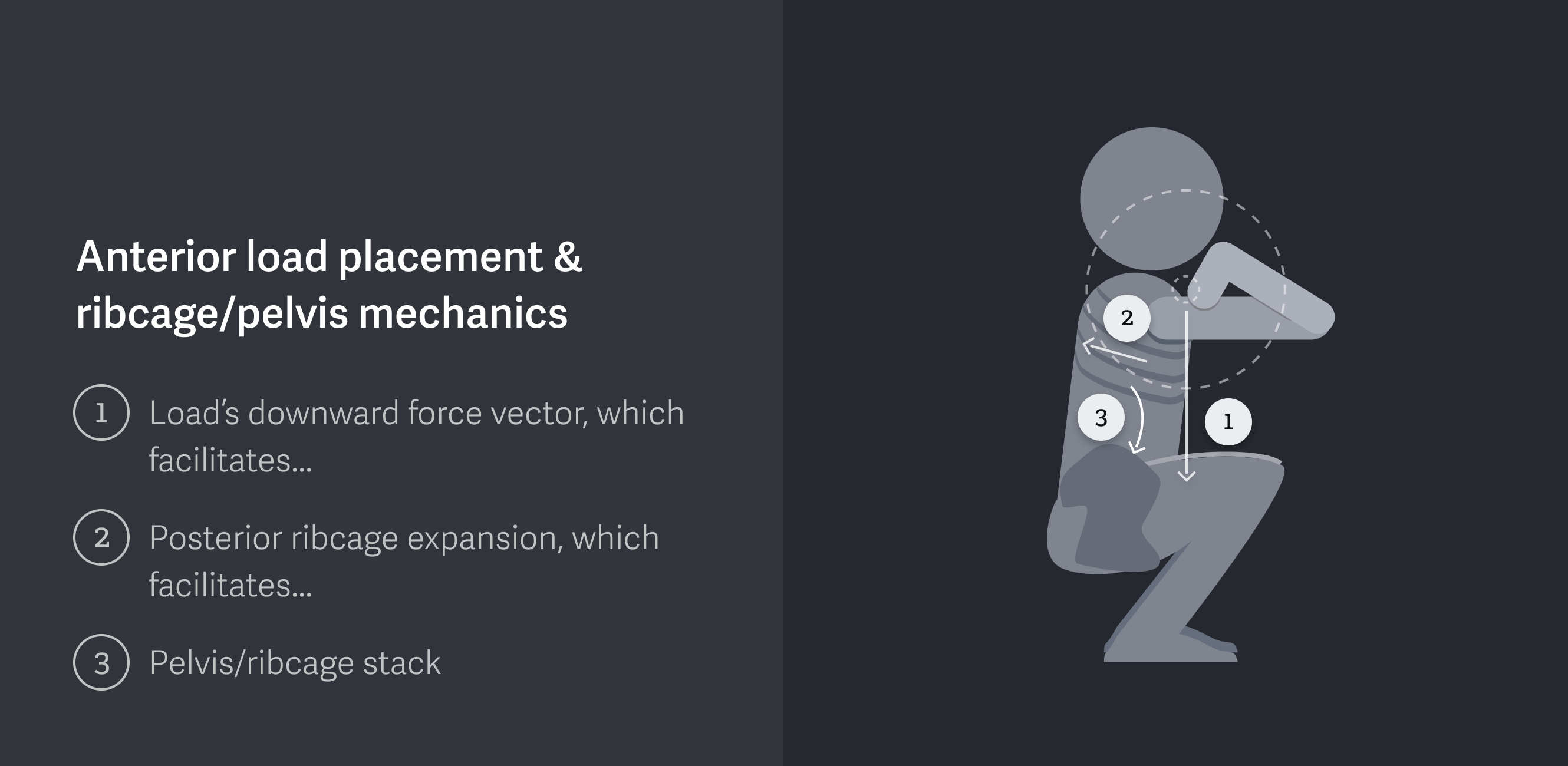
The full diatribe of ribcage function is beyond the scope of this article, but for the purposes of our discussion, the relevant part is that this is a "very good thing" for managing COM and facilitating greater systemic force output.
Anterior loading increases access to knee flexion.
In broadly oversimplifying mechanics of hypertrophy stimulus, we know two key things: muscles like length, and they like load.
The neutrally-tilted orientation of the pelvis in the stacked position affords greater access to hip flexion before we inevitably "run into our own bodies". With the pelvis oriented in a neutral tilt, the superior edges of the acetabulum are positioned more superiorly and more posteriorly. This socket orientation allows the hip joint to flex to a greater degree before the femur "runs aground" and contacts the acetabulum.
The implication to knee flexion is significant - since squatting patterns express hip flexion and knee flexion in simultaneous coordination, more hip flexion combined with anterior load placement means that we're able to access more loaded knee flexion, all while maintaining sound up-chain mechanics.
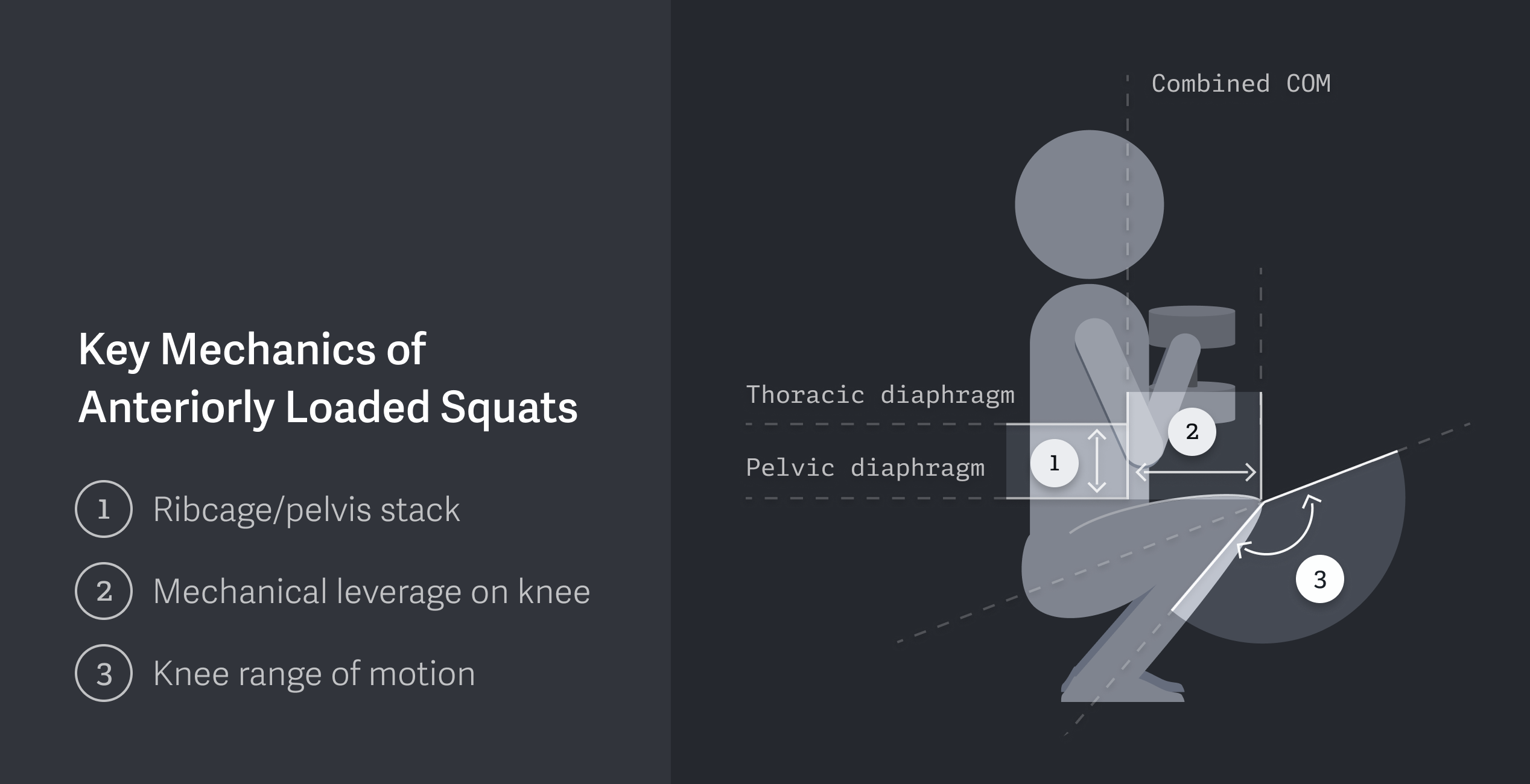
Running aground on hip flexion doesn't necessarily mean that the knee can't flex any further- but it does mean that further knee flexion will require reciprocal articulation through the spine/SI joints; the hip is blocked from flexing any further, which means that the pelvis must "tuck under" the trunk to continue downward movement.
The specifics of anteriorly loaded squat variations.
Regardless of which variation you choose, the primary benefit on offer with anteriorly loaded squat variations is developing centre of mass management.
Good centre of mass management pays enormous dividends throughout the full scope of a training program. With the ability to bias muscle recruitment, axially transfer greater forces, and keep our muscle origin points stable, we can:
- Apply tension with precision to target tissues.
- Apply greater magnitudes of tension to target tissues.
- Greatly increase net training stimulus.
${component=BasicCard}Goblet Squat
Out of all of the meaningfully loadable squat variations, the goblet squat involves the most anterior possible placement of the load- and its usefulness extends far beyond the regressive reputation it has (somewhat) unfairly garnered.
The heavily anterior placement of a dumbbell/kettlebell in "goblet" fashion serves as a functional counterbalance to the ribcage and pelvis, removing the vast majority of mechanical barriers that impede ideal pelvis-ribcage alignment. Furthermore, the position of the load (and its corresponding force vector) "coerces" the ribcage and pelvis into adopting perfect alignment.
There's also the obvious fact that the exercise is more "knee dominant" in nature: the relative orientation of the body in response to goblet loading not only places a much greater force production demand on knee extension, but also significantly increases the degree of knee flexion that can be expressed through the movement- especially when combined with the greater access to knee extension afforded by the stacked position.
All told, these mechanical factors add up to loading high forces across a extremely long range of knee flexion in the quadriceps muscle group. The mechanics of the goblet squat's loading will place an inherent glass ceiling on absolute loadability. The exercise can still be extremely useful once loading is maxed out, but for that, you'll need reach into your bag of programming tricks (more on that below).
${component=BasicCard}Front Squat
The Front Squat emphasizes the load side of the mechanical equation, positioning the barbell much more closely, but still anteriorly, to the lifter's own centre of mass. This means that the exercise has an extremely long runway of progress- mostly as a hypertrophy exercise, but also to a certain degree in strength development.
Like the Goblet Squat, the load's anterior placement in the Front Squat biases an ideal ribcage-pelvis orientation.
Furthermore, the barbell is self-correcting mechanism. Since the bar is positioned on the lifter's anterior deltoids, it "strongly encourages" the lifter to maintain an upright posture: dumping the trunk forward will result in either losing the bar or awkwardly loading the wrists. The net result is an effective "guardrail" that constrains execution to a certain level of quality. It's certainly still possible to do the Front Squat poorly, but only to a certain point of loading, before the bar inevitably slides off the shoulders. Such instances will be painfully obvious .
The efficiency benefit: train hypertrophy and function at the same time.
Exercises like anteriorly loaded squat variations are unique opportunities to train both a key functional ability (COM organization) and a key objective program goal (quad hypertrophy) at the same time.
They're an "easy" way to develop good COM organization and pelvic stability for lower body training. Better still, you get to develop these qualities while doing exercises that look, feel, and acts like a "real" exercise that one would choose to grow their quads.
In other words, it kills two training birds with one exercise stone- and it's certainly a lot less boring than fiddling away with bands.
${component=Step}Goblet Squats: Best used for COM management & pre-fatigued hypertrophy
The Goblet Squat has two key advantages, which guide its ideal use:
- It's an easy way to teach the stacked position / COM management.
- It's dead simple to execute.
In considering the former, the Goblet Squat can be used as an initial teaching drill for newbies, or as a deliberate core/COM management exercise for more advanced populations. In either case, tempo is your best friend:
- 2-3 second eccentric phase to emphasize COM translation and movement coordination
- 2-3 second pause at the bottom to emphasize core stability
- 2 second pause at the top to emphasize the pelvis-ribcage stack
As for the latter, the Goblet Squat can be applied as a decent hypertrophy tool for athletes of wide range of progression. In this capacity, the exercise works best when prefaced by some measure of prefatigue, which can take the form of a superset, or of a later position in exercise order.
${component=Step}Use the Front Squat as a long-term staple of strength, hypertrophy, and functional development.
The front squat is a perfect example of an exercise with excellent training efficiency: it wraps up multiple key training intents/adaptations into a single exercise, and allows those intents to be expressed through meaningful loading:
- Lower body strength and quad development
- Centre of mass management development
This exercise chases both of these objectives simultaneously- again, with meaningful load. The benefits of loadability with respect to these objectives can't possibly be overstated. You don't often find exercises in which you meaningfully can chase multiple key competencies/goals at once.
- Greater hypertrophy stimulus via increased mechanical tension
- Greater strength stimulus via increased neural coordination and recruitment demand
- Greater COM management demand via heavier axial loading
Implement the front squat as a long-term fixture of your program for strength and quad hypertrophy development. Applied consistently, this exercise serves as a handy touchpoint for developing COM management, conveniently progressing this crucial capability in parallel with gains from across the program.
Since the front squat aligns more closely with traditional barbell-based strength exercises, it wins most when it uses a relatively heavier load/lower rep programming scheme. The ultimate selection of program variables depends on your primary intent for using the exercise:
When prioritizing centre of mass management stability, or execution technique, apply a tempo similar to that indicated for the Goblet Squat
When prioritizing strength and quad hypertrophy, consider tempo initially as a temporary execution guardrail, progressively removing tempo segment-by-segment as execution improves. Select load and volume parameters according to strength or hypertrophy biases in your program objectives; 6-8 rep ranges serve as a good range in this capacity, but is by no means a hard-and-fast rule.
${component=Step}Carry forward COM management into lunges, hinges, and other exercises.
Centre of mass management is a highly transferrable capability, which acts as a training stimulus multiplier whenever it's mindfully applied.
Quality COM coordination creates a favourable environment for a highly stable pelvis, which ultimately cascades to greater gains:
- A stable pelvis (origin point) means that greater tension can be applied to target tissues by way of intentional muscle contraction.
- Greater tension applied to target tissues means greater training stimulus.
- Greater training stimulus means greater adaptation.
When thoughtfully applied to lower body movements, you're able to organize your centre of mass in such a way as to better stabilize your pelvis, better transfer force, and better lever the musculature targeted for hypertrophy adaptations. The upshot is a greater exposure of hypertrophy and strength stimulus to target musculature.